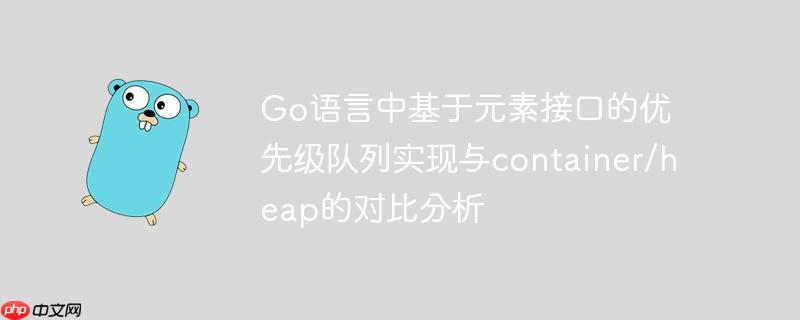
本文深入探讨了一种在Go语言中实现优先级队列的通用方法,其核心在于将接口定义在队列元素本身。我们将详细分析该实现的代码结构、工作原理,并将其与Go标准库container/heap包进行对比,阐述两种设计哲学(接口在元素 vs. 接口在容器)的优劣、适用场景及潜在的性能考量,旨在为Go开发者选择合适的优先级队列方案提供指导。
理解优先级队列
优先级队列是一种抽象数据类型,它允许我们以优先级的方式存储和检索元素。在优先级队列中,每个元素都关联一个优先级,高优先级的元素总是先于低优先级的元素被取出。它广泛应用于各种算法和系统中,例如事件调度、dijkstra最短路径算法、霍夫曼编码等。
在Go语言中,实现泛型数据结构通常依赖于接口(interface{})和类型断言。标准库提供了container/heap包,这是一个通用的堆实现,但其设计哲学是将接口定义在容器上。本文将分析另一种将接口定义在元素上的优先级队列实现,并探讨其优缺点。
Go语言中基于元素接口的优先级队列实现
这里展示的prio包提供了一种将优先级队列接口直接应用于队列元素的设计。这意味着任何希望被放入此队列的类型都必须实现prio.Interface。
prio.Interface定义
type Interface interface { // Less 返回此元素是否应在元素x之前排序。 Less(x Interface) bool // Index 在此元素被移动到索引i时,由优先级队列调用。 Index(i int) }
- Less(x Interface) bool: 这是定义元素优先级比较规则的核心方法。如果当前元素应排在x之前,则返回true。
- Index(i int): 这是一个非常独特且关键的方法。它允许队列在元素在底层切片中移动时,通知元素其新的索引位置。这对于需要通过索引快速移除元素的场景(如Dijkstra算法中的“减少键”操作)非常有用,因为元素可以自行维护其在堆中的位置。
prio.Queue结构及核心操作
prio.Queue结构体内部维护一个[]Interface切片作为底层堆。
type Queue struct { h []Interface }
该包提供了标准的优先级队列操作:
立即学习“go语言免费学习笔记(深入)”;
- New(x …Interface) Queue: 创建一个新的优先级队列,并用给定元素初始化。时间复杂度为O(n)。
- Push(x Interface): 将元素x推入队列。时间复杂度为O(log n)。
- Pop() Interface: 移除并返回队列中的最小元素(最高优先级)。时间复杂度为O(log n)。
- Peek() Interface: 返回但不移除队列中的最小元素。
- Remove(i int) Interface: 移除并返回指定索引i处的元素。时间复杂度为O(log n)。此方法得益于Index接口,允许元素自行更新其位置。
- Len() int: 返回队列中元素的数量。
内部堆维护机制
为了维持堆的属性,prio包实现了一组内部函数:
- heapify(h []Interface): 将一个无序切片转换为一个堆。
- up(h []Interface, i int): 当索引i处的元素优先级升高时,将其向上移动以恢复堆属性。
- down(h []Interface, i int): 当索引i处的元素优先级降低时,将其向下移动以恢复堆属性。
这些函数在内部负责调用元素的Index方法,确保元素能够追踪其在堆中的位置。
示例代码
以下是prio包的完整实现:
// Copyright 2012 Stefan Nilsson // // Licensed under the Apache License, Version 2.0 (the "License"); // you may not use this file except in compliance with the License. // You may obtain a copy of the License at // // http://www.apache.org/licenses/LICENSE-2.0 // // Unless required by applicable law or agreed to in writing, software // distributed under the License is distributed on an "AS IS" BASIS, // WITHOUT WARRANTIES OR CONDITIONS OF ANY KIND, either express or implied. // See the License for the specific language governing permissions and // limitations under the License. // Package prio provides a priority queue. // The queue can hold elements that implement the two methods of prio.Interface. package prio /* A type that implements prio.Interface can be inserted into a priority queue. The simplest use case looks like this: type myInt int func (x myInt) Less(y prio.Interface) bool { return x < y.(myInt) } func (x myInt) Index(i int) {} To use the Remove method you need to keep track of the index of elements in the heap, e.g. like this: type myType struct { value int index int // index in heap } func (x *myType) Less(y prio.Interface) bool { return x.value < y.(*myType).value } func (x *myType) Index(i int) { x.index = i } */ type Interface interface { // Less returns whether this element should sort before element x. Less(x Interface) bool // Index is called by the priority queue when this element is moved to index i. Index(i int) } // Queue represents a priority queue. // The zero value for Queue is an empty queue ready to use. type Queue struct { h []Interface } // New returns an initialized priority queue with the given elements. // A call of the form New(x...) uses the underlying array of x to implement // the queue and hence might change the elements of x. // The complexity is O(n), where n = len(x). func New(x ...Interface) Queue { q := Queue{x} heapify(q.h) return q } // Push pushes the element x onto the queue. // The complexity is O(log(n)) where n = q.Len(). func (q *Queue) Push(x Interface) { n := len(q.h) q.h = append(q.h, x) up(q.h, n) // x.Index(n) is done by up. } // Pop removes a minimum element (according to Less) from the queue and returns it. // The complexity is O(log(n)), where n = q.Len(). func (q *Queue) Pop() Interface { h := q.h n := len(h) - 1 x := h[0] h[0], h[n] = h[n], nil h = h[:n] if n > 0 { down(h, 0) // h[0].Index(0) is done by down. } q.h = h x.Index(-1) // for safety return x } // Peek returns, but does not remove, a minimum element (according to Less) of the queue. func (q *Queue) Peek() Interface { return q.h[0] } // Remove removes the element at index i from the queue and returns it. // The complexity is O(log(n)), where n = q.Len(). func (q *Queue) Remove(i int) Interface { h := q.h n := len(h) - 1 x := h[i] h[i], h[n] = h[n], nil h = h[:n] if i < n { down(h, i) // h[i].Index(i) is done by down. up(h, i) } q.h = h x.Index(-1) // for safety return x } // Len returns the number of elements in the queue. func (q *Queue) Len() int { return len(q.h) } // Establishes the heap invariant in O(n) time. func heapify(h []Interface) { n := len(h) for i := n - 1; i >= n/2; i-- { h[i].Index(i) } for i := n/2 - 1; i >= 0; i-- { // h[i].Index(i) is done by down. down(h, i) } } // Moves element at position i towards top of heap to restore invariant. func up(h []Interface, i int) { for { parent := (i - 1) / 2 if i == 0 || h[parent].Less(h[i]) { h[i].Index(i) break } h[parent], h[i] = h[i], h[parent] h[i].Index(i) i = parent } } // Moves element at position i towards bottom of heap to restore invariant. func down(h []Interface, i int) { for { n := len(h) left := 2*i + 1 if left >= n { h[i].Index(i) break } j := left if right := left + 1; right < n && h[right].Less(h[left]) { j = right } if h[i].Less(h[j]) { h[i].Index(i) break } h[i], h[j] = h[j], h[i] h[i].Index(i) i = j } }
如何使用
为了使用prio包,你需要定义一个自定义类型并使其实现prio.Interface。例如:
package main import ( "fmt" "prio" // 假设prio包在你的GOPATH中 ) // 定义一个需要优先级排序的结构体 type Item struct { value string priority int index int // 存储其在堆中的索引 } // 实现 prio.Interface 的 Less 方法 func (x *Item) Less(y prio.Interface) bool { return x.priority < y.(*Item).priority } // 实现 prio.Interface 的 Index 方法 func (x *Item) Index(i int) { x.index = i } func main() { // 创建一些 Item 实例 item1 := &Item{value: "任务A", priority: 3} item2 := &Item{value: "任务B", priority: 1} item3 := &Item{value: "任务C", priority: 2} // 初始化优先级队列 pq := prio.New(item1, item2, item3) fmt.Printf("队列长度: %dn", pq.Len()) // 输出: 队列长度: 3 // 查看最小元素 minItem := pq.Peek().(*Item) fmt.Printf("最小元素: %s (优先级: %d)n", minItem.value, minItem.priority) // 输出: 最小元素: 任务B (优先级: 1) // 弹出最小元素 poppedItem := pq.Pop().(*Item) fmt.Printf("弹出元素: %s (优先级: %d)n", poppedItem.value, poppedItem.priority) // 输出: 弹出元素: 任务B (优先级: 1) fmt.Printf("队列长度: %dn", pq.Len()) // 输出: 队列长度: 2 // 再次查看最小元素 minItem = pq.Peek().(*Item) fmt.Printf("当前最小元素: %s (优先级: %d)n", minItem.value, minItem.priority) // 输出: 当前最小元素: 任务C (优先级: 2) // 演示Remove方法,需要先找到索引 // 假设我们想移除 item1 (任务A) // 在实际应用中,你可能需要一个map来根据value找到Item的指针,然后用其index字段来调用Remove // 这里我们直接使用 item1.index (在Push或New时,Index方法已被调用更新) fmt.Printf("任务A的当前索引: %dn", item1.index) // 此时 item1.index 可能是0或1,取决于堆结构 // 注意:这里的item1.index是在pq初始化后,item1被heapify或up/down操作时更新的。 // 如果你直接用New初始化,item1的index可能不是你期望的,因为它可能已经被移动。 // 正确的Remove通常用于在外部修改了某个元素的优先级后,需要更新其在堆中的位置, // 或者通过某种方式获取到元素的当前索引。 // 为了演示,我们假设 item1 仍在队列中,并且我们知道其当前索引。 // 在本例中,item1在初始化的切片中是第一个,但经过heapify,其index可能改变。 // Pop后,item1的index可能被改变。 // 假设我们现在知道item1的index是0 (如果它在堆顶),或者1 (如果它在第二个位置) // 这里我们直接使用 item1.index 来移除 if item1.index != -1 { // 检查元素是否仍在队列中 removedItem := pq.Remove(item1.index).(*Item) fmt.Printf("移除元素: %s (优先级: %d)n", removedItem.value, removedItem.priority) fmt.Printf("队列长度: %dn", pq.Len()) } }
设计哲学:元素接口 vs. 容器接口
prio包与Go标准库container/heap包在设计哲学上存在根本差异:
-
prio包(接口在元素上)
- 核心思想: 将堆操作所需的接口(Less, Index)定义在要存储的元素类型上。
- 优点:
- 用户需要实现的接口方法数量较少(2个)。
- 内置了索引管理:Index方法使得元素能够自行追踪其在堆中的位置,这对于需要高效执行“减少键”(Decrease Key)或“删除任意元素”等操作的算法(如Dijkstra)非常方便。
- 包本身管理底层切片,用户无需关心容器的实现细节。
- 缺点:
- 牺牲了一定的通用性:底层容器固定为[]Interface,如果用户已有其他容器结构(如链表、自定义数组),则无法直接使用。
- Index方法即使在不需要索引管理的场景下也会被调用,可能引入轻微的性能开销。
- 需要对元素类型进行类型断言(如y.(*Item).priority),如果处理不当可能导致运行时错误。
-
container/heap包(接口在容器上)
- 核心思想: 将堆操作所需的接口(Len, Less, Swap, Push, Pop)定义在包含元素的容器类型上。
- 优点:
- 高度通用: 允许用户使用任何满足heap.Interface的容器类型,无论是[]int、[]*MyStruct,甚至是自定义的复杂数据结构,只要能提供索引访问和交换能力。这使得它与Go的切片、数组等原生数据结构结合得非常紧密。
- 更灵活: 用户可以完全控制底层数据结构,例如,可以在堆中存储指针,而实际数据存储在另一个map或slice中。
- 无额外开销: 如果不需要索引管理,就不会有Index方法调用的开销。
- 缺点:
- 用户需要实现的接口方法数量更多(5个)。
- 不直接提供Remove指定索引元素的功能,如果需要,用户必须自行管理元素的索引(例如,通过在外部map中存储元素到其在堆中索引的映射),并在heap.Fix或heap.Remove后手动更新。
prio包与container/heap的详细对比
| 特性 | prio包(元素接口) | container/heap包(容器接口) |
|---|---|---|
| 接口定义位置 | 在元素类型上 (Less, Index) | 在容器类型上 (Len, Less, Swap, Push, Pop) |
| 接口方法数 | 2个 (Less, Index) | 5个 (Len, Less, Swap, Push, Pop) |
| 索引管理 | 内置:元素通过Index方法自行追踪位置,方便Remove操作。 | 需外部管理:不直接提供索引管理,Remove和Fix操作需用户在外部维护索引。 |
| 底层数据结构 | 固定为[]Interface | 灵活:可以是任何满足heap.Interface的切片或自定义结构。 |
| 通用性 | 较低:绑定到[]Interface,限制了底层容器的选择。 | 较高:可与任意可索引、可交换的容器配合使用。 |
| 便利性 | Remove操作更直接,用户无需额外管理索引。 | 对于简单的堆操作,如Push/Pop,同样便利;但Remove或Update操作需要额外代码。 |
| 性能考量 | Index方法的每次调用会带来轻微的函数调用开销。 | 通常性能更高,没有Index方法的额外开销,更接近底层切片操作。 |
| 典型用例 | 需要频繁“减少键”或“删除任意元素”的算法(如Dijkstra),且对底层容器无特殊要求。 | 大多数通用优先级队列场景,对底层容器有特定需求,或需要极致性能时。 |
选择建议与注意事项
选择哪种优先级队列实现取决于你的具体需求:
- 需要内置索引管理(尤其是Remove操作)吗? 如果你的应用场景需要频繁地根据元素的当前位置来更新或移除元素(例如,Dijkstra算法中更新某个节点的距离),那么
go apache go语言 编码 app ai 标准库 red less 数据类型 结构体 bool int 指针 数据结构 接口 堆 Interface 泛型 Go语言 切片 len map 事件 算法


